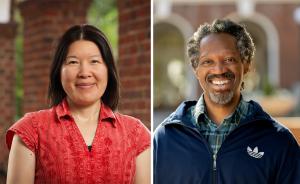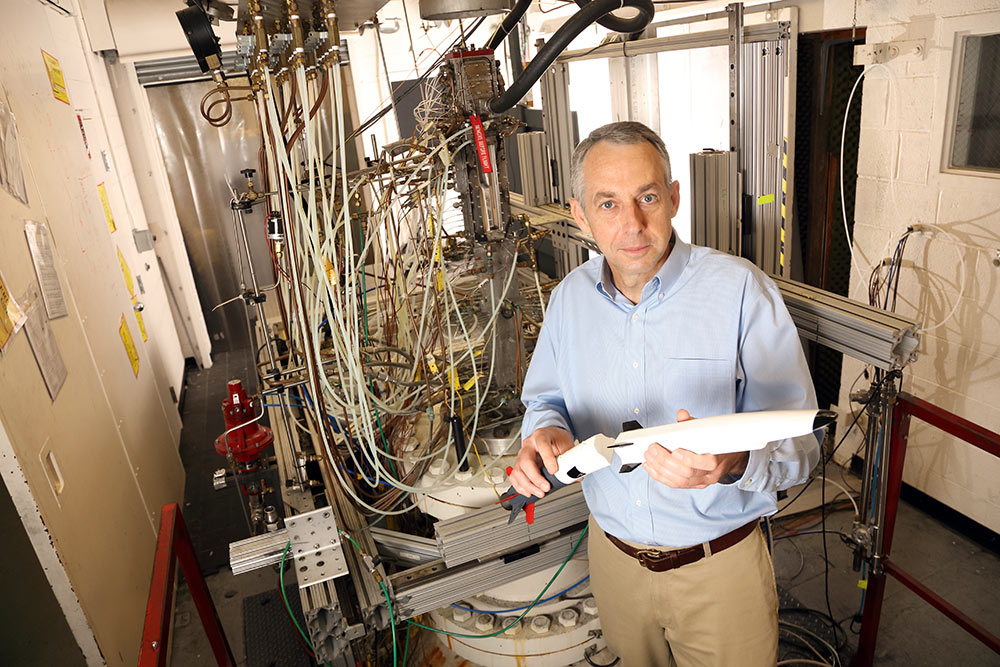
The University of Virginia’s School of Engineering and Applied Science houses a thriving hypersonic research faculty group that spans multiple engineering disciplines. This accomplished and forward-looking group is committed to fostering a new era of high-speed flight, whether they are enhancing United States defense capabilities, facilitating Earth-to-Mars journeys or making intercontinental commuting a reality.
Newly appointed faculty members in the Department of Mechanical and Aerospace Engineering will add even more strength and momentum as they assimilate into the hypersonics research team.
Welcome Thomas Ward: Revisiting Hypersonics Fundamentals
Professor Thomas Ward contributes expertise that examines the heart of hypersonic research. Ward’s extensive research in fluid dynamics and aerodynamics has earned him wide recognition.
“To make headway in hypersonics research, we need to go back to the roots, the fundamental science. The more we can uncover about how physics and materials work at these speeds, the more we can pave the way for breakthroughs in the research areas that depend on this information, like propulsion, materials science and aerodynamics,” Ward said.
Beyond Simulation: Real-World Hypersonic Testing
Following a successful pilot project while at Iowa State University, Ward’s ambitious vision includes the development of a wind tunnel that performs at the extraordinary velocities and temperatures of hypersonic flight.
“We don’t have an abundance of data from real hypersonic flights, only from simulations. With this advanced technology, we aim to gather more precise aerodynamic data to inform our vehicle designs,” he said.
Students will get invaluable hands-on experience helping Ward build the new tunnel.
The new tunnel will complement the department’s supersonic combustion wind tunnel, one of the few in the world that can conduct extended combustion tests at hypersonic conditions.
Welcome Xinfeng Gao: A Computational Trailblazer
Where Ward’s expertise examines fundamental principles, professor Xinfeng Gao’s expertise rests at the other end of the build process. Her expertise is in developing and advancing the modeling and simulation capabilities for aerospace technology by integrating computational fluid dynamics (CFD), data assimilation coupled with machine learning and high-performance computing (HPC).
Gao’s work has the potential to demonstrate high-fidelity simulations of advanced hypersonic capabilities and prototype systems in a realistic operating environment. With her arrival, students will be able to learn from one of the few researchers who apply these methods.
Applying HPC to Multiple Data Sources
Gao’s enhanced HPC CFD capabilities can integrate various data sources and coordinate with existing research projects. This ensures that all research efforts can work together cohesively, maximizing the innovation potential. This method can provide meaningful analyses for both scientists in the lab and vehicle designers in industry.
“The assimilation of experimental data into HPC CFD simulations is not limited to one field,” Gao said. “It can incorporate materials science, combustion, hypersonic flows, shockwave dynamics and more.”
This holistic approach is significantly more effective than depending on models, simulations, physical experiments or wind tunnel testing alone, Gao said.

Christopher Goyne: A Catalyst for Change
Ward and Gao join a diverse group of hypersonic researchers at UVA led by Christopher Goyne, associate professor of mechanical and aerospace engineering and director of the UVA Aerospace Research Lab, who leads hypersonics research at UVA. In addition to his research and expertise in hypersonic ground and flight testing, Goyne’s work extends beyond the walls of the University.
As a key member of the University Consortium for Applied Hypersonics in the area of air-breathing propulsion, he is part of a $100 million U.S. Department of Defense initiative to modernize hypersonic flight capabilities. He is also a member of the consortium’s Governance Board where he leads international teaming efforts. Goyne also serves on the Governor of Virginia’s Aerospace Advisory Council and is chair of the Virginia Space Grant Consortium Advisory Council.
National and Industrial Collaborations
In a rapidly evolving field like hypersonics, broad collaboration is essential.
“Our 35-year history in hypersonic research and proximity to the nation’s capital has facilitated a robust collaborative relationship with the NASA Langley Research Center, a global leader in hypersonic technology, and other national research institutions,” Goyne said.
Hypersonic researchers at UVA Engineering also collaborate extensively with the U.S. Department of Defense, the Defense Advanced Research Projects Agency (DARPA), the U.S. Air Force Research Laboratory and the National Science Foundation.
“The team has contributed to some of the nation’s key hypersonics programs and our materials solutions have been deployed around the world,” Goyne said.
The hypersonic research at UVA Engineering also extends to prominent industrial leaders. Boeing, Lockheed Martin, General Electric, CALSPAN and Specter Aerospace are among the key players who recognize the value of hypersonic research at UVA and actively pursue collaborations.
“Working with industry brings real-world applications to academic research, helping to bridge the gap between theory and practical implementation,” Goyne said.